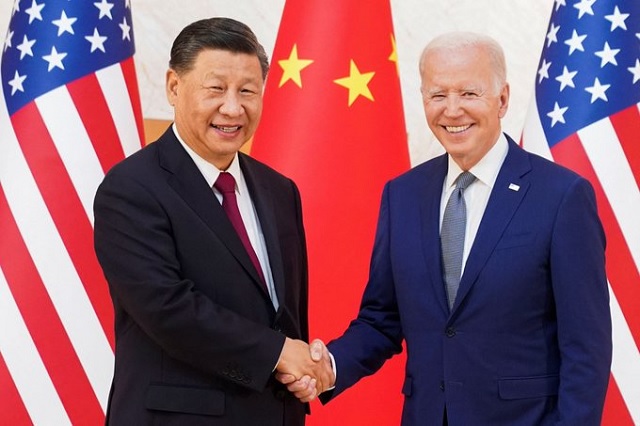
BEIJING, CHINA | Xinhua | As the world counts down to a new year, the China-U.S. diplomatic relationship is set to welcome its 45th anniversary.
Back in November, Chinese President Xi Jinping and his U.S. counterpart, Joe Biden, held a historic meeting in San Francisco. Many, not just Chinese and Americans, are now hoping that the summit is a new starting point for bilateral relations.
“It is the convergence of many streams of goodwill and friendship that has created a strong current surging across the vast Pacific Ocean; it is the reaching out to each other by our peoples that has time and again brought China-U.S. relations from a low ebb back onto the right track,” Xi said at the welcome dinner during his visit to California in November for the China-U.S. summit meeting and the 30th APEC Economic Leaders’ Meeting.
FROM BUDDING TO BLOOMING
Fifty-two years ago, a tiny ping-pong ball played a vital part in the budding rapprochement between China and America after more than two decades of estrangement.
The real breakthrough in ties came with a public encounter between a pair of ping-pong players during the 1971 World Table Tennis Championships in Japan. Footage caught their friendly exchange, and the unexpected goodwill between the American and Chinese teams soon became the talk of the tournament and preluded a milestone visit leading to the establishment of bilateral diplomatic relations.
“That seemingly small gesture had a huge symbolic significance,” Gene Sykes, chairman of the U.S. Olympic and Paralympic Committee, told Xinhua, adding, “The impact of this event went far beyond the realm of sports. It was the opening for a wide range of collaborations which spanned the scientific, cultural, artistic and educational domains.”
Today, this chapter in China-U.S. relations, known as “Ping-Pong Diplomacy,” still resonates over half a century later. The goodwill, which thawed relations between the two countries, dispelled the specter of the Cold War and brought the two countries together, serving as a vivid example of cooperation trumping estrangement.
“History has demonstrated that building bridges is a much better strategy than building walls or digging moats” between the United States and China, said Tom Watkins, a former advisor to the Michigan-China Innovation Center.
“I still remember what ‘Ping-Pong Diplomacy’ was like between the United States and China in the early 1970s and I think we should try it again,” said Stephen Mull, former U.S. acting undersecretary of state for political affairs.
STORYTELLERS, BRIDGE BUILDERS
Friendship between people holds the key to sound relations between states, and people from both sides as storytellers and bridge builders can play their part.
Their bond has laid the groundwork for bilateral ties, helped navigate the relationship through choppy waters, and will continue to work wonders in the years to come.
Despite the tumultuous years in their relations, the Chinese and American peoples at the grassroots level are telling their own stories about each other and emphasize how critical it is to deepen their exchanges, no matter from the business, academic or cultural communities.
U.S. opinion polls have shown that the younger generation has a different attitude towards China compared to the older generation, said Warwick Powell, adjunct professor at the Queensland University of Technology.
“The youths experienced the benefits of exchanges with people from all walks of life and understand that there is no reason why people from different parts of the world cannot find common ground and achieve things together in the interests of everybody,” he said.
Brooke Leonard, a 32-year-old ping-pong aficionado from Los Angeles, said he has gained so much fun from learning, playing and appreciating the sport. Besides making friends with many Chinese through this sport, he is now recommending it to his American friends and family.
In southwest China’s megacity Chongqing, a museum dedicated to the Flying Tigers stands to tell a touching tale of Americans and Chinese fighting side by side during wartime and of how grateful the Chinese people are for their bravery and sacrifice.
In November, an over 30-member delegation of the Flying Tigers veterans and their descendants visited Kunming, the starting point of “the Hump,” a vital airlift route over the Himalayas and the primary way the Allies supplied China between 1942 and 1945 in World War II.
Today, memorials, exhibitions and events to honor that chapter in history epitomize the deep friendship between the two peoples that withstood the test of blood and fire. And more than 1,000 Flying Tigers veterans and their families have been invited to visit China.
Americans, for their part, always remember the Chinese who risked their lives to save American pilots. Offspring of those American pilots often visit the Doolittle Raid Memorial Hall in east China’s Zhejiang Province to pay tribute to the Chinese for their heroic efforts.
From U.S. entrepreneurs visiting China, to “Bond with Kuliang: 2023 China-U.S. People-to-People Friendship Forum,” and from the delegation of U.S. Flying Tigers visiting China, to the fifth China-U.S. Sister Cities Conference, the Chinese and American peoples have demonstrated good will and a firm friendship, injecting impetus into bilateral ties and cooperation.
These heartening stories can help improve the ailing China-U.S. relationship. That is probably the best way to carry on the legacy in the new era.
“THE TIME IS ALWAYS RIGHT TO DO WHAT IS RIGHT”
Martin Luther King, a leading figure of the American civil rights movement in the 1950s, once said, “The time is always right to do what is right.”
The whole world is watching the two major countries, hoping they will continue the positive momentum in their relations from the San Francisco summit and engage in more “maintenance work” regarding their relationship.
There are numerous reasons to make the China-U.S. relationship work. Ordinary people on both sides want this. The world also wants this.
“As a planet, we are facing multiple challenges — the need to nourish the hungry, manage climate change, sustain economic growth and job creation, and maintain global stability. We hope there will be a positive reset and improved relations between the two major countries,” said Grant Kimberley, a sixth-generation soybean farmer and marketing director of the Iowa Soybean Association.
The future depends on joint efforts from both peoples, particularly from the younger generation. For China-U.S. relations, the hope lies in the people, the foundation rests on the people, and the future lies with the youth.
To increase bilateral exchanges, particularly between the youth, China has announced a plan to invite 50,000 young Americans to China on exchange and study programs in the next five years. Meanwhile, a growing number of young Americans have joined the Flying Tigers Friendship Schools and Youth Leadership Program, launched by the Sino-American Aviation Heritage Foundation in 2022.
These tangible efforts, step by step, have helped nurture the seeds of friendship, mutual understanding, and cooperation on both sides.
“The more exchanges, whether they’re educational, sports or music, or any kind of exchange between our two countries … if we can learn to do that, I think we can break down barriers and open up communication that is just phenomenal,” said Connie Sweeris, the American table tennis champion who took part in the ice-breaking trip to China in 1971.
“We have been partners in war, now let us always be partners in peace,” said Mel McMullen, a Flying Tigers veteran. ■
 The Independent Uganda: You get the Truth we Pay the Price
The Independent Uganda: You get the Truth we Pay the Price


